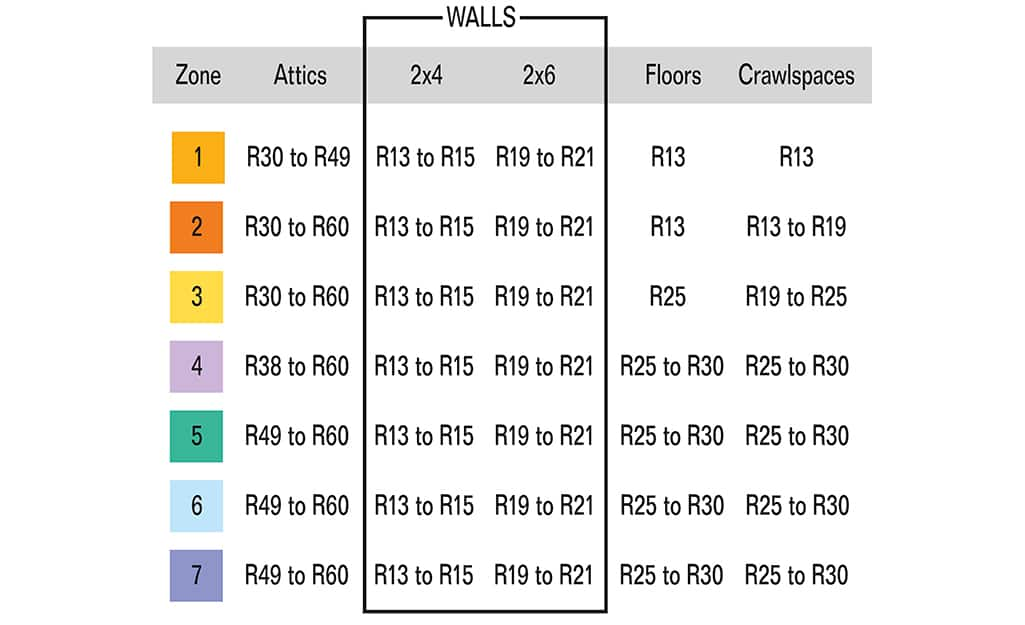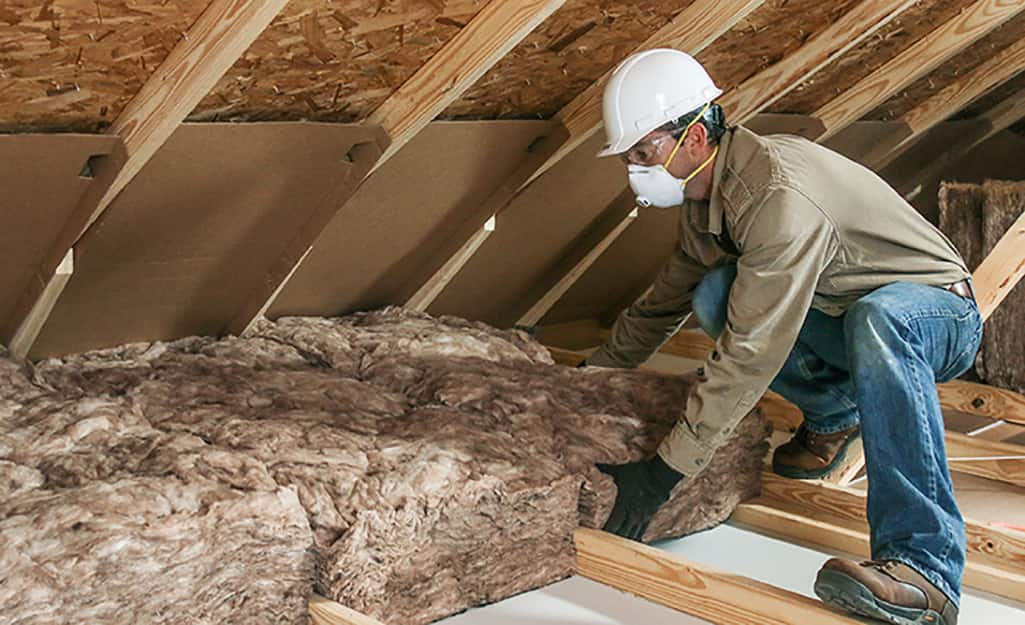Buying Guide
Types of Insulation
Most of the energy used in your home is for heating and cooling. Having your home well insulated is key to keeping the temperature comfortable and your energy bills low. This guide will teach you about the different types of insulation and where to insulate your home.
How Insulation Works

Insulation decreases the amount of heat entering from outside when it’s hot, and traps warmth inside when it’s cold. Insulation is rated by its R-value. R-value measures how resistant types of insulation are to heat flow. R-values vary based on the type, thickness and density of the insulation material. Typically, a higher R-value means better climate control and better energy efficiency for your home. However, your home may not need insulation with the highest R-value. The Department of Energy recommends different insulation levels based on your region to increase energy efficiency.
Most homes are insulated in the attic and any floors located above unfinished basements or crawl spaces. The most effective places to add insulation to older homes are exterior walls, attics, basements and crawl spaces. No matter how old your home is, it’s a good idea to see if there are ways to improve its insulation. The North American Insulation Manufacturers Association reports that about 90-percent of single-family homes in the U.S. don’t have sufficient insulation.
How Much Insulation Do You Need?

To get an idea how much insulation is needed to cover your house, check if your home is already insulated. Then measure the area needing insulation and determine which type of insulation is best.
Our insulation calculator can help you determine how much your home will need.
- Determine if and where you already have insulation. If you do have insulation, find out the type and compare it to industry standards.
- Calculate additional insulation needed. Measure the depth of your current insulation. R-38 is the industry standard, and the minimum thickness for R-38 is 12-inches. If your current insulation is only 5-inches deep, you’ll need to add seven inches of insulation to achieve the 12-inch R-38 rating.
- Measure the area needing insulation. Measure the length and width of the area you need to insulate. Multiply the length times the width to determine the square footage of the space.
- Decide on the type of insulation to use. The home insulation types will have different units. For example, loose-fill insulation is calculated based on depth, while blanket insulation is based on the number of batts or rolls you need.
Types of Insulation

R-value requirements also vary based on the spot in your home in which the insulation is installed. When it comes to the best insulation for walls, the insulation material can also impact the R-values needed for good energy efficiency.
Insulation Materials
- Fiberglass: Fiberglass is the most common insulation material. It’s made from fine glass fibers and is most often used in batts, rolls and loose-fill insulation. Fiberglass is a skin and lung irritant, so always wear protective eyewear, gloves, masks and clothing when working with fiberglass insulation.
- Cellulose: Cellulose insulation is made from recycled paper products. Manufacturers also add borate for fire and insect resistance. Cellulose insulation is usually a loose-fill insulation.
- Foam: Foam insulation may be made from polystyrene, polyisocyanurate or polyurethane, which are all types of plastic. You can also install cementitious foam insulation, which is cement-based. Foam insulations can be sprayed or installed in rigid foamboards.
- Mineral wool: Mineral wool can refer to either rock wool or slag wool. Rock wool is a man-made material made from a combination of natural minerals. Slag wool is also a man-made material but is made from a waste product of molten metal known as slag. Both mineral wool insulations are naturally fire-resistant. They come as batts, rolls and loose-fill.
- Natural fibers: Insulation can also be made from various natural materials, including cotton, sheep’s wool, straw and hemp. Typically, these materials are from recycled sources and are treated to be fire, mold and insect resistant.
- Denim insulation is made from recycled jeans and post-industrial denim cotton. Denim is non-toxic and non-irritating, making it easy for DIYers to install. It’s typically more expensive than fiberglass or other insulation materials.
- The most common insulation materials are fiberglass, cellulose and foam. Home insulation types include any of the above materials in the form of loose-fill, batts, rolls, foam board, spray foam and radiant barriers.
Loose Fill Insulation

Loose-fill insulation, also known as blown-in insulation, is blown or sprayed into place with special equipment. You can rent an insulation blowing machine to install this insulation yourself, but most choose to leave this installation to professionals.
- Best for attics, hard-to-reach or oddly shaped areas and already insulated areas.
- Usually made of fiberglass, cellulose or mineral wool.
- Blown or sprayed into place with pneumatic equipment.
- Can fill wall cavities.
- Mid-range prices when compared to other insulation types.
- R-values range from R-2.2 to R-3.8, depending on the insulation material
Insulation Batts

Batt insulation is a type of insulation blanket. These are pre-cut sections of insulation that are usually fiberglass, although cellulose, mineral wool, natural fibers and plastic versions are also available.
- Best for unfinished walls, floors and ceilings.
- Designed for easy handling and use between framing, such as studs and joists, making it among the best insulation for walls.
- Installed in pieces.
- DIY-friendly.
- One of the most affordable types of insulation.
- Available either with or without paper or aluminum foil facing. Facing helps prevent interior heat from escaping and water vapor from passing through the insulation. Install the batt so that the facing is the exposed side.
- Standard fiberglass batts have R-values ranging from R-2.9 to R-3.8 for every inch of thickness, but high-density insulation batts can have R-values as high as R-4.3 per inch.
Rolled Insulation

Rolled insulation is another type of insulation blanket similar to batt insulation. The main difference between insulation batts and rolls is that batts are installed in pieces, while rolls are rolled out between wall and ceiling framing. Insulation rolls leave less opportunity for gaps between sections, making them sometimes more effective than batts.
- Best for unfinished walls, floors, ceilings and wherever long and continuous insulation pieces are needed.
- Available in pre-cut widths to fit between studs and joists.
- Come in continuous lengths ranging from 20- to 40-feet.
- DIY-friendly.
- Another one of the most affordable types of insulation. Comparable in price to batts.
- Like batts, standard fiberglass rolls have R-values ranging from R-2.9 to R-3.8 for every inch of thickness. High-density insulation rolls can have R-values as high as R-4.3 per inch.
Foam Board Insulation

Foam board or insulating boards are rigid panels of insulation that have a high R-value. Because they have a high R-value and can be used nearly anywhere in your home, foam board insulation is one of the most common types of insulation.
- Best for floors, foundation and basement walls, interior and exterior wall sheathing and low-sloped ceilings.
- Can be used to insulate almost any part of your home, from the roof down to the foundation.
- Usually made from polystyrene, polyisocyanurate
Spray Foam Insulation

Spray foam insulation is a liquid latex or polyurethane foam that expands and hardens to fill gaps. For large insulating jobs, professionals spray this insulation into place with special equipment. For small sealing jobs, spray foam is available in spray cans.
- Best for hard-to-reach or oddly shaped areas and already insulated areas.
- Can be used to fill small gaps and cracks or to insulate large spaces.
- Ideal for sealing around doors, windows and vents.
- Sets quickly and can be trimmed, painted or stained.
- Has two types: open-cell foam and closed-cell foam. Closed-cell foam is denser and thus has a higher R-value. Closed-cell foam is usually more expensive than open-cell foam.
- Open-cell foam has an approximate R-value of R-3.7 per inch of thickness.
- Closed-cell foam has an approximate R-value of R-6.2 per inch of thickness.
- Sheathing reduces heat conduction through structural elements like wood and steel studs.
- Great insulation choice for cold climates.
- DIY-friendly.
- Typically more expensive per square foot than other insulations.
- R-values range from R-4 to R-6.5 per inch of thickness.
Radiant Barriers

A radiant barrier is a type of insulation that reflects heat away from your home instead of reducing the flow of heat out of your home, like most other insulations.
- Best for attics, unfinished walls, ceilings, floors and attached garages in hot climates.
- Designed to keep your home cool.
- Made from a reflective material such as aluminum foil over a substrate like kraft paper or foam board.
- DIY-friendly.
- Most often used for attics, since most heat enters through the attic.
- Not measured in R-values.
Vapor Barriers

A vapor barrier is a material that prevents water vapor from passing into your walls and ceilings during cold weather. If moisture from either direction builds up within stud or cavity walls, the heat-conducting moisture will cause the insulation to lose its R-value. Mold and rot can also set in over time.
- Best for interior and exterior walls in cold or humid climates, especially for homes with masonry or wood walls.
- House wraps and kraft-faced insulation are examples of vapor barriers that help control the amount of moisture that passes through the insulation.
- Most used when framing the exterior walls of a house.
- Installed after insulation.
- DIY-friendly.
- Not measured in R-values.
Where to Insulate

- Insulate your attic, outer walls and crawl space first, as these areas have the most heat transfer.
- Insulate water heaters to prevent costly energy loss. Look for insulating pre-cut jackets or blankets with an insulating value of at least R-8. Adding insulation to your water heater can reduce standby heat losses by 25- to 45-percent. This will save you around 4- to 9-percent in water heating costs.
- Wrap hot water pipes with tubular insulation to prevent freezing and help keep water hot. Use quality pipe insulation wrap. Insulating your hot water pipes reduces heat loss and can raise water temperature by 2- to 4-degrees Fahrenheit vs. non-insulated pipes, so you can use a lower temperature setting.
- Insulated heating and air conditioning vent ducts operate more efficiently and vibrate less, reducing noise. Properly insulating air ducts located in unconditioned spaces such as attics, crawl spaces, garages or unfinished basements can help improve your home’s energy efficiency.
Choosing the best home insulation types depends on your location and the current state of your home’s insulation. Plus, consider whether you want to install the insulation yourself or have a professional installation. If you don’t have all the tools you need to install insulation yourself, use tool rental services.
